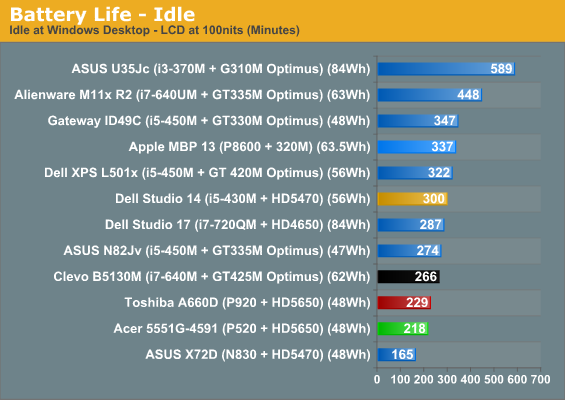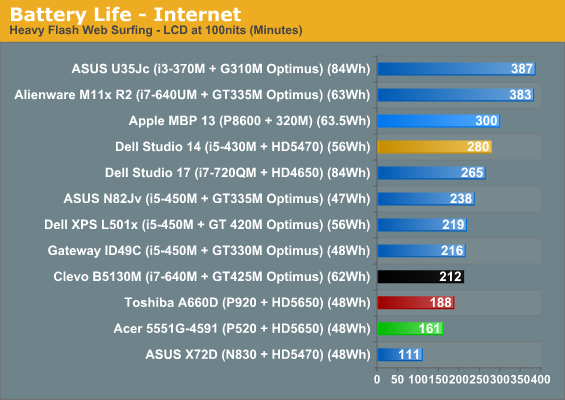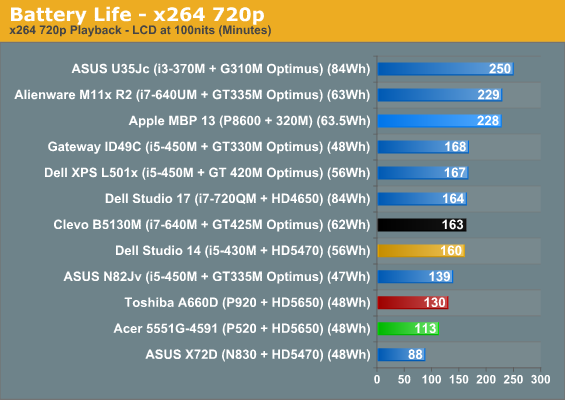Acer's Aspire 5551G: AMD's Budget Gaming Laptop
by Jarred Walton on November 27, 2010 12:00 AM ESTBattery Life
We've run our usual gamut of battery tests, and here the 5551G clearly falls short of the competition. Toshiba and HP both have AMD laptops with switchable graphics, and shutting off the HD 5650 dGPU on the Toshiba A660D looks to improve battery life by perhaps 18% in our best-case result. That's actually not as large a gap as we expected, but the results that really hurt AMD all come from Intel laptops—with or without dedicated graphics. Here's a look at some of the latest laptops and how they compare to the 5551G.





Idle battery life is the optimal result you can get, and we've even removed "unnecessary" applications and utilities so we're running a clean setup with no firewall or anti-virus software. In such a configuration, the 5551G nets just over 3.5 hours of battery life. That's not horrible, considering the paltry (but typical) 48Wh battery, but the problem is with Internet usage—a far more realistic scenario. Here the 5551G drops to a bit more than 2.5 hours, and for movie playback it just misses the two hour mark. It's not the end of the world, but without the use of AMD's IGP we're certainly not going to catch Optimus-enabled laptops.
If we compare with the older Acer 5740G (which was likewise discontinued far too quickly for our likes!), battery life is generally a wash. The 5740G had slightly lower idle and Internet battery life but tied in x264 battery life. As another comparison point, Dell's Studio 14 with an Intel CPU and a discrete GPU (granted, it's a slower HD 5470 GPU) manages five hours of idle battery life and 4.5 hours of Internet use, though it also suffers in the x264 test with a result of just 2.5 hours. If we account for the larger 56Wh battery in the Studio 14, Intel's platform with HD5470 is still leading the AMD P520+5650 by 18-49% depending on workload. How much of that comes from the difference in GPU? It's tough to say for sure, but we suspect Dell may have spent a bit more time optimizing for battery life.
Ultimately, when we factor in the much higher CPU performance that Core 2010 offers relative to AMD's processors, it's easy to see why most laptop manufacturers aren't keen on shipping us AMD-based laptops. If you want performance, Intel's Core 2010 parts win easily; Intel also dominates in performance per watt (ULV) and pure battery life (Atom). But then, AMD wins with a better IGP and typically far more affordable prices (outside of Atom netbooks, which we're not too keen on anyway). Hopefully all this will change when we start to see the next generation CPUs from AMD—all those Bulldozer, Bobcat, Zacate, Brazos, Ontario, Llano, etc. codenames we periodically discuss. Where will those solutions fall in the pantheon of laptops? We'll have to wait and see, but with power gating and other enhancements we should see much better battery life from AMD next year.
Temperatures and Noise
Temperatures are quite good, with both the CPU and GPU topping out at around 65C—well within margins for mobile chips. The hard drive likewise stays at a consistent temperature. Again, we don't know exactly where HWMonitor gets the power information, but it's interesting to see a maximum power draw of 20W for the P520, with a minimum power draw of only 3.15W. That's quite good and would make for much better battery life; unfortunately, the chipset, discrete GPU, and other components appear to be consuming the lion's share of the power. At idle, the laptop bottoms out at around 13W of power use, which is almost 3W higher than the Dell XPS 15 with Optimus.
Noise levels are actually very good for a midrange 15.6" laptop—some of the lowest we've measured. Idle noise measures 33dB and load noise topped out at 55dB. Considering the temperatures, the low noise levels are even more impressive.











36 Comments
View All Comments
JarredWalton - Monday, November 29, 2010 - link
But ASUS' keyboards and build quality are at least better than Acer (the keyboards are FAR better IMO!), and if you get the Optimus models you have better battery life. I don't *hate* Acer, but you cannot convince me that the keyboards are good. I've used dozens of laptops and I type large portions of each article on the laptop in question. Every time, the Acer/Gateway keyboard leaves me very unhappy.flexy - Monday, November 29, 2010 - link
There is no such thing as a "gaming laptop" with a display < 17", IMO.
JarredWalton - Monday, November 29, 2010 - link
Sure there is. ASUS G53Jw, MSI GX660, Alienware M15x, HP Envy 15.... Are you saying you prefer 17" and larger for gaming laptops, or am I missing something?PSbench - Wednesday, December 1, 2010 - link
I don't know why people put up with such low resolution on a 15 inch screen (1366x768)Hrel - Thursday, December 2, 2010 - link
The price seems fair for what you get, saw it for $550 at Costco. I'd easily be willing to pay an extra 150 if they included a 1080p screen and that 84Whr battery. Switcheable graphics would be nice to have too; granted with that battery I wouldn't need it.Elanie - Monday, October 8, 2018 - link
nice